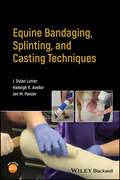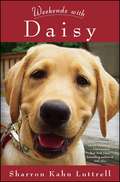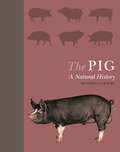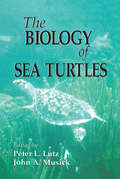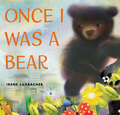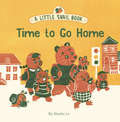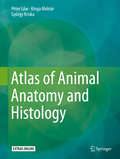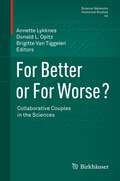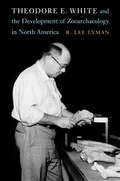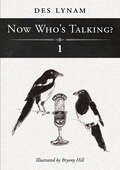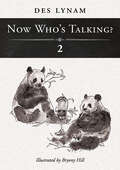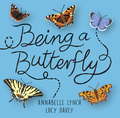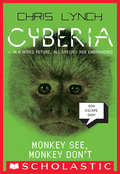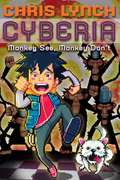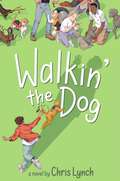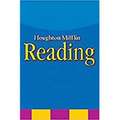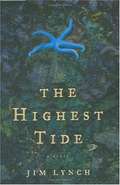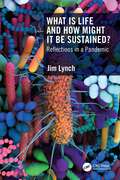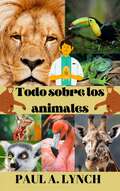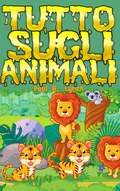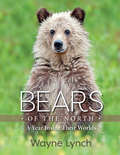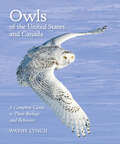- Table View
- List View
Equine Bandaging, Splinting, and Casting Techniques
by J. Dylan Lutter Haileigh K. Avellar Jen M. PanzerEquine Bandaging, Splinting, and Casting Techniques A practical reference manual dealing with a vital component of clinical practice in equine medicine The application of bandages, splints, and casts is an essential part of equine surgical and veterinary care. Traditionally, however, there have been few available resources wholly dedicated to application techniques. The result is that equine veterinary practitioners learn to bandage, splint, and cast on the job, with highly variable results; some practitioners are unwilling even to attempt a cast, spurning this valuable healing tool entirely rather than attempt it from an uncertain base of knowledge. Equine Bandaging, Splinting, and Casting Techniques offers the first comprehensive reference to this specific set of techniques and their applications in equine veterinary medicine. It promises to cultivate a rigorous, clinically tested, consistent standard of care that will improve patient outcomes and long-term owner costs. It is a must-own for any veterinary practitioner who works with equine patients. Equine Bandaging, Splinting, and Casting Techniques readers will also find: Step-by-step organization guides reader smoothly through each process Practical tips and advice for improving quality and appearance of bandages and casts Over 270 color images, including clinical examples and radiographs, supplementing every listed technique Equine Bandaging, Splinting, and Casting Techniques is ideal for all veterinary practitioners, technicians, and students interested in equine care.
Weekends with Daisy
by Sharron Kahn LuttrellCurrently in development with CBS Films, this is the emotional and uplifting memoir of a woman who became a volunteer trainer for Daisy, a sweet yellow Lab puppy, and her unique relationship with the inmate who is Daisy's partner in the Prison PUP program.When Sharron Luttrell, a journalist still deeply mourning the loss of her family dog, found out about a weekend puppy raiser program for a service dog organization, she knew it was just she needed to help her move on. It seemed ideal; pick up a puppy on Friday, return it on Sunday night, get a new puppy each year. No strings attached. Well, it turns out that there were strings - and they tugged at her every Sunday evening when she had to return "her dog" to prison. This memoir chronicles Sharron's year co-parenting Daisy, a sweet lab puppy, with Keith, a convicted felon serving a decades-long sentence. As Sharron and Keith develop a rapport based on their brief weekend handovers (an exchange she describes as "divorced parents handing over the kids"), she begins to speculate about what the quiet, gentle Keith could have done to wind up in medium-security prison. When, through an accident of fate, Sharron finally discovers the crime Keith actually committed, she is shaken to her foundation. How can she continue to work with him, knowing what she does? But can she dismiss her personal experience with him, which has been nothing but kind? Ultimately, she looks to Daisy to pull her through--she must "think like a dog" and react in the present, not the past. Mindful of how much Daisy has taught her in a short time, Sharron can also see how much this special dog has helped Keith learn empathy, remorse, and to face the consequences of his actions. As the two of them work tirelessly to ensure that Daisy passes her final test and fulfills her destiny by becoming a service dog, Sharron tests the limits of her own strength, compassion, and capacity for love.
The Pig: A Natural History
by Richard LutwycheA comprehensive, richly illustrated introduction to the fascinating natural history of the pig, from prehistory to the present At any given time, there are around one billion pigs in the world; that's one for every seven of us. And where would we be without them? Prolific, ubiquitous, smart, adaptable, and providers of high-quality protein, pigs have been our companions since neolithic times, when they obligingly domesticated themselves, coming in from the wild to root around our waste pits. But it's not all about the bacon; today, bred in micro sizes, the resourceful pig has developed a whole new career as a popular pet. And thanks to genome mapping, we now know that the pig shares many common physiological features with humans, spurring the use of pig tissue and organs in medical research and surgery. Beautifully designed and illustrated, The Pig provides a snout-to-tail natural history of this important species, from the prehistoric "hell pig" to today's placid porker, covering the pig's evolution and domestication, anatomy and biology, behavior, role in human life and culture, and breeds. The book also features an engrossing and visually stunning photographic gallery of some thirty popular breeds from around the world, with essential information about each. Filled with surprising facts and insights, The Pig will delight anyone who loves these animals and wants to understand them better. Provides a comprehensive, richly illustrated introduction to the pig's evolution and domestication, anatomy and biology, behavior, role in human life and culture, and breeds. Features infographics, diagrams, and 250 stunning color photographs. Includes a beautiful photographic directory to some 30 popular breeds from around the world, with essential information about each
The Biology of Sea Turtles, Volume I (CRC Marine Science #12)
by Peter L. Lutz John A. MusickSea turtles have existed for millions of years, making them fascinating subjects of study. In the last 20 years, the science of sea turtle biology has expanded at an exponential rate, leading to major advances in many areas. This book synthesizes the results of these advances and focuses on how these endangered marine reptiles operate in, adapt to, and are dependent upon particular features of their marine environment. New technology in data gathering, such as DNA analyses, remote sensing, and physiological monitoring techniques, has led to a much greater understanding of the biology of the sea turtle at all stages of their life history.
Once I Was a Bear
by Irene LuxbacherA beautiful, beguiling tale about adapting to change and finding your place. Especially comforting during this time of social distancing and uncertainty about the future."Imaginative and poetically resonant." -- Kirkus Reviews"Considers nature's way of connecting us to ourselves and to others...poetically expresses feelings of dislocation, vulnerability, and strength." -- Quill & Quire, starred reviewOh, to be a bear in the forest! To rest and play, day after day, always feeling safe and at home. But when change fills the air, and it's time to journey into a different kind of wilderness, will it ever feel the same?This sensitively imagined story illuminates the difficult transitions we all must face as we learn how to be at home in the world.
A Little Snail Book: Time to Go Home
by Shasha LvWelcome to the whimsical world of Little Snail and friends!Time to Go Home celebrates the different routes and routines each friend undertakes on their way home from school—with a playful twist at the end.Animals of all shapes and sizes abound in this sweet, feel-good board book infused with friendship and fun.• Themes of school and travel help the youngest of readers better understand the world around them.• Features bright, unique illustrations and bold, beautiful colors• Teeming with cute animal characters to make your little one giggleLittle Snail serves up a delightful surprise, proving that the smallest of creatures can be special indeed.This charming book delivers delight with wit, humor, and ample sweet and silly moments.• Ideal for children ages 0 to 3 years old• A great pick for preschool and kindergarten teachers looking for a crowd-pleasing picture book for little students• Perfect for parents, grandparents, and caregivers• You'll love this book if you love books like Franklin Goes to School by Paulette Bourgeois; Preschool, Here I Come! by David J Steinberg; and Daniel Goes to School by Becky Friedman.
Atlas of Animal Anatomy and Histology
by Péter Lőw Kinga Molnár György KriskaThis atlas presents the basic concepts and principles of functional animal anatomy and histology thereby furthering our understanding of evolutionary concepts and adaptation to the environment. It provides a step-by-step dissection guide with numerous colour photographs of the animals featured. It also presents images of the major organs along with histological sections of those organs. A wide range of interactive tutorials gives readers the opportunity to evaluate their understanding of the basic anatomy and histology of the organs of the animals presented.
For Better or For Worse? Collaborative Couples in the Sciences
by Annette Lykknes Donald L. Opitz Brigitte Van TiggelenIn this volume, a distinguished set of international scholars examine the nature of collaboration between life partners in the sciences, with particular attention to the ways in which personal and professional dynamics can foster or inhibit scientific practice. Breaking from traditional gender analyses which focus on divisions of labor and the assignment of credit, the studies scrutinize collaboration as a variable process between partners living in the nineteenth and twentieth centuries who were married and divorced, heterosexual and homosexual, aristocratic and working-class and politically right and left. The contributors analyze cases shaped by their particular geographical locations, ranging from retreat settings like the English countryside and Woods Hole, Massachusetts, to university laboratories and urban centers in Berlin, Stockholm, Geneva and London. The volume demonstrates how the terms and meanings of collaboration, variably shaped by disciplinary imperatives, cultural mores, and the agency of the collaborators themselves, illuminate critical intellectual and institutional developments in the modern sciences.
Theodore E. White and the Development of Zooarchaeology in North America (Critical Studies in the History of Anthropology)
by R. Lee LymanTheodore E. White and the Development of Zooarchaeology in North America illuminates the researcher and his lasting contribution to a field that has largely ignored him in its history. The few brief histories of North American zooarchaeology suggest that Paul W. Parmalee, John E. Guilday, Elizabeth S. Wing, and Stanley J. Olsen laid the foundation of the field. Only occasionally is Theodore White (1905–77) included, yet his research is instrumental for understanding the development of zooarchaeology in North America. R. Lee Lyman works to fill these gaps in the historical record and revisits some of White’s analytical innovations from a modern perspective. A comparison of publications shows that not only were White’s zooarchaeological articles first in print in archaeological venues but that he was also, at least initially, more prolific than his contemporaries. While the other “founders” of the field were anthropologists, White was a paleontologist by training who studied long-extinct animals and their evolutionary histories. In working with remains of modern mammals, the typical paleontological research questions were off the table simply because the animals under study were too recent. And yet White demonstrated clearly that scholars could infer significant information about human behaviors and cultures. Lyman presents a biography of Theodore White as a scientist and a pioneer in the emerging field of modern anthropological zooarchaeology.
Vertebrate Taphonomy
by R. Lee LymanTaphonomy studies the transition of organic matter from the biosphere into the geological record. It is particularly relevant to zooarchaeologists and paleobiologists, who analyse organic remains in the archaeological record in an attempt to reconstruct hominid subsistence patterns and paleoecological conditions. In this user-friendly, encyclopedic reference volume for students and professionals, R. Lee Lyman, a leading researcher in taphonomy, reviews the wide range of analytical techniques used to solve particular zooarchaeological problems, illustrating these in most cases with appropriate examples. He also covers the history of taphonomic research and its philosophical underpinnings. Logically organised and clearly written, the book is an important update on all previous publications on archaeological faunal remains.
Now Who's Talking? 1
by Obe Des LynamDiscover the animal kingdom as you’ve never seen it before! In this charming and witty book, with words by Des Lynam and illustrations by Bryony Hill, creatures ranging from squirrels and butterflies to baby hedgehogs and tiger cubs finally get a chance to speak for themselves, revealing their quirks and habits in a way that’s sure to delight readers of all ages. Whether you’re a die-hard animal lover or just looking for a good laugh, Des and Bryony’s unique perspective is guaranteed to leave you with a smile on your face – and every so often, perhaps, tell you something you didn’t know about our winged and furry friends. ‘Quirky in the best possible way. Putting words into animal’s mouths is no easy thing, but that is exactly what Des has managed to do. It talks to us of being human – and also of being animal – but expressed in a way that we can relate to. And the illustrations take the words to another level: a perfect match!’ Jonathan and Angela Scott (aka The Big Cat People), award-winning photographers and conservationists
Now Who's Talking? 2
by Obe Des LynamAre you ready for round two of Now Who’s Talking? Des Lynam returns with more animal antics in this second collection of conversations, once again illustrated by Bryony Hill. This time, they’re heading to the farm and the zoo to eavesdrop on an even wider variety of animals, ranging from ferrets and turkeys to flamingos and crocodiles. Just as in the previous volume, Des gives voice to the animals in a way that mirrors their behaviour in the real world, while at the same time offering some intriguing insights into their interactions with us humans. As ever, Des’s words are perfectly complemented by Bryony’s imaginative yet realistic drawings. ‘Full of charm, novelty, and wit – just like the man himself.’ Susie Dent ‘I loved Des’s voice. It was always one of my favourites to imitate (“Wine ’em… dine ’em… Lynam”). Now the old master’s found a whole range of voices and applied them to the birds and animals in his garden and beyond. Whimsical, witty, imaginative – and great fun.’ Rory Bremner
Being a Butterfly (Being a Minibeast #3)
by Annabelle LynchDiscover how a caterpillar transforms into a bright, beautiful butterfly in this wonderfully illustrated picture bookBeing a Butterfly brings a butterfly's brief, precious life cycle to beautiful life. Follow the story of a little green caterpillar as it hatches, grows and transforms itself into a bright, colourful butterfly. Learn how butterflies move, feed themselves and pollinate flowers, before finding a mate and beginning the whole cycle of life again.This wonderfully illustrated picture book is a perfect introduction to life cycles for readers aged 5 and up. It also gently introduces them to the idea of conservation.List of contents: Left on a leafHatching outA greedy caterpillarShedding skinTime to restChanging timesA beautiful butterflyLearning to flyFinding flowers Billions of butterfliesFinding a mateNew eggsProtecting butterfliesGlossaryFind out more
Cyberia #2: Monkey See, Monkey Don't (Cyberia #2)
by Chris LynchFrom National Book Award nominee Chris Lynch, the second action-and-humor-filled futuristic series about talking pets who are tired of being pets ... and the boy who must help them. Zane has made an enemy for life in the evil scientist Dr. Gristle. Not only is Gristle angry about the damage Zane has done to his reputation, he's also extraordinarily jealous of Zane's ability to use technology to talk to animals. The result? He's now working on a new device to control animals' movements and speech - and Zane's dog, Hugo, is one of the first targets.
Monkey See, Monkey Don't (Cyberia #2)
by Chris LynchZane has made an enemy for life in the evil Dr. Gristle, who is jealous of Zane's ability to use technology to talk to animals. He's now working on a new device to control animals' movement and speech--and Zane's dog is one of the first test cases.
Walkin' the Dog
by Chris Lynch&“Lynch is back and better, smarter, and funnier than ever.&” —Jacqueline Woodson, National Book Award Winner A boy learns how to be a friend from man&’s best friend in this funny and moving middle grade novel about humans being able to change and dogs changing us from acclaimed author Chris Lynch.In a family of strong personalities with very strong points of view, Louis is what his mother lovingly calls &“the inactivist,&” someone who&’d rather kick back than stand out. He only hopes he can stay under the radar when he starts high school in the fall, his first experience with public school after years of homeschooling. But when a favor for a neighbor and his stinky canine companion unexpectedly turns into a bustling dog-walking business, Louis finds himself meeting an unprecedented number of new friends—both human and canine. Agatha, a quippy and cagey girl his age always seems to be telling two truths and a lie. Cyrus, a few years his senior, promises he&’s going to show Louis how to be a better person, whether Louis wants him to or not. And then there are the dogs: misbehaving border terriers, the four (possible stolen) sausage dogs, the rest of Louis&’s charges, and a mysterious white beast who appears at a certain spot at the edge of the woods. Dogs and human alike all seem to have something they want to teach Louis, including his menacing older brother who keeps turning up everywhere. But is Louis ready to learn the lesson he needs most: how to stop being a lone wolf and be part of a pack?
At Home on the Prairie (Houghton Mifflin Harcourt Vocabulary Readers #Leveled Reader: Level: 4, Theme: 6.3)
by Jesse David LynchA brief explanation of the prairies of the United States and the animals that live on them.
The Highest Tide: A Novel
by Jim LynchMiles O'Malley, 13-year-old insomniac, naturalist, worshipper of Rachel Carson, and dweller on the mud flats of Skookumchuck Bay, at the South end of Puget Sound near Olympia, Washington, is the irresistible center of The Highest Tide. He says, "I learned early on that if you tell people what you see at low tide they'll think you're exaggerating or lying when you're actually just explaining strange and wonderful things as clearly as you can" and "People usually take decades to sort out their view of the universe, if they bother to sort at all. I did my sorting during one freakish summer in which I was ambushed by science, fame and suggestions of the divine." And what a summer he has! Miles, who is licensed to collect marine specimens for money, slips into his kayak late one night when he can't sleep and begins his exploratory rounds. What he sees is not the usual collectibles. He hears a deep exhale, a sound of release, and comes eye to eye with a giant squid. But, there are no giant squid in Puget Sound or anywhere around it--and when they are seen by humans, they are always dead. His discovery is confirmed by Professor Kramer, a local biologist and Miles's friend. Television cameras arrive, everyone wants to interview this small-for-his-age but very smart boy and the events of the summer begin to unfold. Jim Lynch has an ability to tell a tale that glows on every page. He knows everything that lives in or near the water by name and habit. This knowledge and his sense of wonder at the natural world brings the reader very close to his story, both in its setting and its characters. One early morning Miles says, "...the water was so clear I could see coon-stripe shrimp ... and the bottomless bed of white clam shells ... Those shells, as unique and timeless as bones, helped me realize that we all die young, that in the life of the earth, we are houseflies, here for one flash of light." Such insights are perfectly natural coming from Miles, whose interests are not garden-variety. He has a mad crush on the mixed-up 18-year-old girl next door, a randy age-mate named Phelps, and a deep friendship with Florence, the elderly woman his mother refers to as "a crazy witch." Florence is a psychic of sorts and her powers come into play when she predicts an extremely high tide on a certain day. All of these relationships and what is happening between Miles's parents are part of this event-filled, life-changing summer.
What Is Life and How Might It Be Sustained?: Reflections in a Pandemic
by Jim LynchHow did the universe and life begin and what are the threats to people and the environment in a pandemic? This book is for anybody with interest in protecting life on the planet. Studies on the origin of life and scientific contributions to safeguarding the planet are examined in light of current thinking on climate change. A major focus is the spread of microbes, put in the context of environmental assessment and management, including descriptions of microbiomes and a consideration of the risks of genetic modifications. Professor Lynch shows how failure to control disease can lead to the collapse of any biotic population. To avoid this, the ethics of management of disease by biological control and by vaccination are discussed, at the practical level and in a moral theological context.
The Life of a Monarch Butterfly (Fountas & Pinnell Benchmark Assessment System 1 #Level M, Nonfiction)
by Patricia LynchThe Life of a Monarch Butterfly Author: Patricia Ann Lynch
Todo sobre los animales: Aprende todo lo posible sobre algunos de nuestros animales más queridos.
by Paul A. LynchLos animales se encuentran por toda la Tierra, lo que quiere decir que, si viajásemos a cada país del planeta, encontraríamos a un animal viviendo allí. Algunos animales viven en climas cálidos, y otros en climas fríos. Llevan existiendo eones. Algunos, como los lagartos, las tortugas, y los peces, llevan existiendo más tiempo que los dinosaurios. Lee este libro de no-ficción y aprende todo lo posible de algunos de nuestros animales más queridos.
Tutto sugli animali
by Paul A. LynchGli animali sono ovunque sulla terra. Questo significa che se dovessimo viaggiare in ogni paese e continente troveremmo un animale che ci vive. Alcuni animali vivono in un clima caldo e altri in un clima freddo. Gli animali esistono da secoli. Alcuni animali come lucertole, tartarughe e pesci sono in giro da più tempo dei dinosauri. Leggete questo breve libro di saggistica e imparate tutto quello che potete sui nostri animali più amati.
Bears of the North: A Year Inside Their Worlds
by Wayne LynchAn unprecedented visual and scientific journey into the secret world of bears.In Bears of the North, renowned wildlife photographer, naturalist, and bestselling author Wayne Lynch offers us a work of scintillating science and stunning beauty. Following polar bears, brown bears, and American and Asiatic black bears through the seasons, this journey is an insider's view of hibernation's mysteries and the birth of cubs in winter; the mating rituals and voracious appetites of spring; hunting, fishing, and encounters with neighbors during summer; and the feeding frenzy and exuberant play of autumn. Dispelling the stereotypes and untruths—but none of the magic—surrounding these magnificent animals, Lynch comments on the latest scientific discoveries related to the biology, behavior, and ecology of bears. He describes how satellite telemetry has revealed the purpose behind the meanderings of bears and the great distances they sometimes cover on land and in water. He also shows how DNA analysis can teach us about the relatedness of bears within a population, even revealing the identity of a particular cub's father. Taking us out into the wilds of the tundra and forests to share his firsthand observations of the marvelous bears of the Northern Hemisphere, Lynch describes their survival strategies and the threats they face from habitat fragmentation and global climate change. Lynch's fascinating narrative is enhanced by over 150 gorgeous, original color photographs that capture bears in their habitats, including appearances of the elusive moon bear, fierce polar bear battles, and rare images of mothers' intimate moments with their cubs. Informed by Lynch's nearly forty years of experience observing and photographing bears in the wild, and aided by sophisticated digital photo technologies, Bears of the North is an unrivaled collection of enthralling and informative portraits of bears in their natural environments.
Owls of the United States: A Complete Guide to Their Biology and Behavior
by Wayne LynchAn extensive, accessible guide to the owls of Canada and the United States, featuring beautiful photography.There is no group of birds more mysterious and fascinating than owls. The loudmouths of the raptor world, they peep, trill, toot, bark, growl, shriek, whistle, chittle, whoop, chuckle, boom, and buzz. Indeed, very few actually “hoot.” They have become the stuff of lore and legend?from the Roman myth that an owl foot could reveal secrets, to the First Nations belief that an owl feather could give a newborn better night vision. But the truth about owls is much more exciting.In this book, natural history writer and wildlife photographer Wayne Lynch reveals the secrets of these elusive species with stunning photographs, personal anecdotes, and accessible science. The photos alone are masterpieces. Unlike most published owl photos, which are portraits of birds in captivity, the vast majority of these were taken in the wild?a product of the author-photographer’s incredible knowledge and patience.Lynch complements the photos with a wealth of facts about anatomy, habitat, diet, and family life. For each of the nineteen species that inhabit Canada and the United States, he provides a range map and a brief discussion of its distribution, population size, and status. Lynch debunks myths about owls’ “supernatural” powers of sight and hearing, discusses courtship rituals, and offers personal tips for finding owls in the wild.From the great horned to the tiny elf owl, this amazing volume captures the beauty and mystery of these charismatic birds of prey.Named one of the Best Reference Books of 2007 by Library Journal
Owls of the United States and Canada: A Complete Guide to Their Biology and Behavior
by Wayne LynchNamed One of the Best Reference Books of 2007 by Library JournalThere is no group of birds more mysterious and fascinating than owls. The loudmouths of the raptor world, they peep, trill, toot, bark, growl, shriek, whistle, chittle, whoop, chuckle, boom, and buzz. Indeed, very few actually "hoot." They have become the stuff of lore and legend—from the Roman myth that an owl foot could reveal secrets to the First Nations belief that an owl feather could give a newborn better night vision. But the truth about owls is much more exciting.In this gorgeous book, celebrated natural history writer and wildlife photographer Wayne Lynch reveals the secrets of these elusive species with stunning photographs, personal anecdotes, and accessible science. The photos alone are masterpieces. Unlike most published owl photos, which are portraits of birds in captivity, the vast majority of these were taken in the wild—a product of the author-photographer's incredible knowledge and patience. Lynch complements the photos with a wealth of facts about anatomy, habitat, diet, and family life. For each of the nineteen species that inhabit Canada and the United States, he provides a range map and a brief discussion of its distribution, population size, and status. Lynch debunks myths about owls' "supernatural" powers of sight and hearing, discusses courtship rituals, and offers personal tips for finding owls in the wild. From the great horned to the tiny elf owl, this amazing volume captures the beauty and mystery of these charismatic birds of prey.
